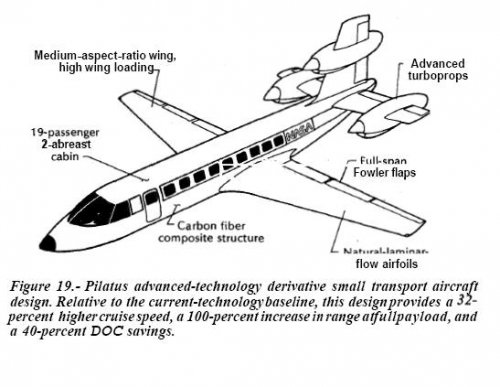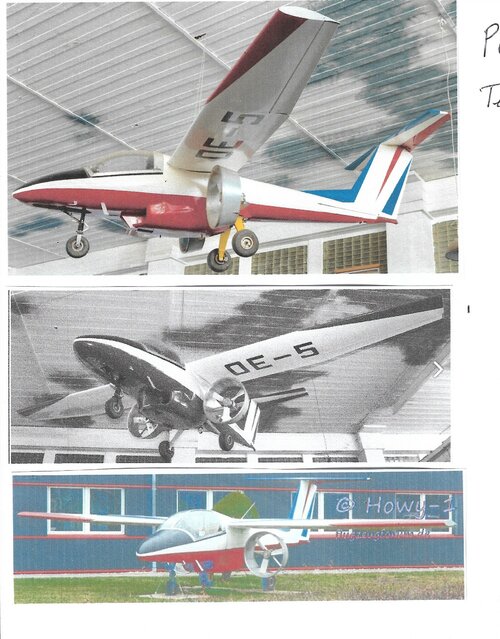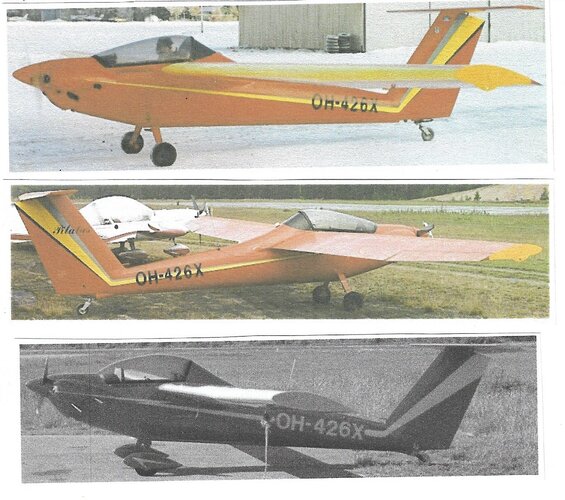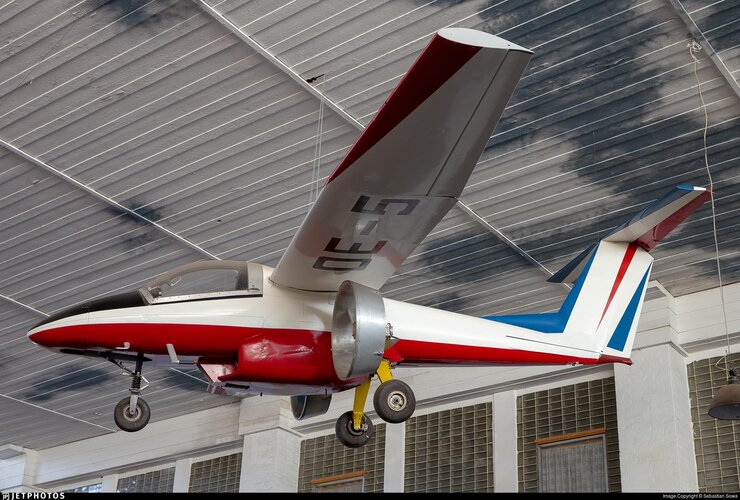- Joined
- 25 July 2007
- Messages
- 4,299
- Reaction score
- 4,193
Pilatus Flugzeugwerke AG, Stans, Switzerland
Most Pilatus designations are relatively straightforward. Originally, numbered designs were simply prefixed 'P' for Pilatus. The PC-6 designation sprang from its design name, 'Pilatus Commercial Nr. 6'. Since then, all internal Pilatus aircraft designs have received the 'PC' prefix.
The Pilatus designation style varies. Variations seen on 'P' and 'PC' designation display include hyphens, periods, spaces (and, sometimes no spaces), between letters and numerals. Pilatus, itself, now uses hyphens so I have stuck to that style. Variations like 'PC-XII' are strictly marketing efforts.
Variations are also seen on suffices ... best illustrated by the PC-6 Porter series. With most piston-engined Porters, variants are designed soley by horsepower, eg: PC-6/350. However, the one-off PC-6/D-H3 follows the Turbo Porter pattern. Here the basic sub-type is shown as PC-6/A and a slight variation would be PC-6/A1. Major changes would result in a new sub-type, PC-6/B. In some renderings, the sub-type 'slash' is omitted, eg: PC-6B2-H2
The 'H' suffix in that PC-6B2-H2 (or PC-6/B-H2) designation indicates an maximum take-off weight class. The 'base' MTOW class receives no 'H' suffix. As MTOW is increased from that 'base', the suffixes '-H1, '-H2, '-H3, and '-H4 would be applied. (Note that not all sub-types had the complete sequence of 'H' suffixes applied.)
Pilatus designation anomolies are the 1944 SB prefixes (Schweizerisches Bergflugzeug or Swiss Mountain-Aircraft, see Reply #15); glider designs built by Pilatus which retain their original designations; and, the long-form B4-PC11 designations applied to the licenced PC-11 gliders.
One further anomoly occurs due to a joint study project - the PD-01 - between Pilatus and Poligrat Development GmbH of Munich. According to Flight International (25 April 1974), the "new Master Porter PD-01 light cargo/passenger transport in the Skyvan class [...was ...] being constructed under a contract agreement with Pilatus." However, it seems highly unlikely that any actual construction work on a PD-01 prototype ever began.
http://www.flightglobal.com/pdfarchive/view/1974/1974 - 0664.html
For undesignated Pilatus designs, see Pilatus post-war projects:
http://www.secretprojects.co.uk/forum/index.php/topic,8379.0.html
______________________________
Pilatus - Anomolous Powered-Aircraft Designations
SB-2 - 1944 Pelican STOL utility a/c, 1 + 5, x 1 (HB-AEP)
- SB-2: 1 x 450 hp P&W R-985 Wasp Junior, span 15.5 m
-- http://www.secretprojects.co.uk/forum/index.php/topic,12611.0.html
-- http://blogs.ethz.ch/digital-collections/files/2010/07/pelicanplan1_fur_blog.jpg
SB-5 - [Project] 1944 SB-2 deriv., 9-pax transport, 1000 hp engine
PD-01 - [Project] 1974 joint* study for enlarged, 24 pax Twin Porter
- PD-01: Master Porter: Rear ramp, 2 x 1120 shp PT6A-45, retractable u/c
-- * Poligrat Development GmbH, Germany and Pilatus Flugzeugwerke
-- http://3.bp.blogspot.com/_Ur4hnBNmc...AAA1A/mGv2jINlGpU/s1600/Photo+pilatus+016.jpg
______________________________
Pilatus Flugzeugwerke - Anomolous Glider Designations
WLM-1 - 1947 single-seat glider for Fliegertruppe, x 3
- WLM-1: Design by engineers Weber Landolf-Münch, span 14 m
Spyr V - 1948 2-seat (staggered) glider, mixed const, span 18.44 m
- Spyr V: Devel. of Ing. A Hug's single-seat Spyr IV glider
______________________________
Pilatus - 'P' and 'PC' Aircraft Designations
P-1 -- [Project] 1940-41* single-seat fighter trainer, span 9.2 m
- P-1: 1 x 240 hp Argus As 10E2 V-8, mixed construction
-- * Design begun 1940, internal project approval 1941
P-2 -- 1946 tandem 2-seat military trainer (related to P-1 project)
- P-2-01: Prototype (HB-GAB/A-101/U-101), 465 hp Argus As 410-A2
- P-2-02: Static test airframe
- P-2-03: 1 x 500 hp SLM-built HS-12Mb-57 V-12, ventral radiator
-- * HS-12Mb-57 engines came from FF Tp Dewoitine D 27 fighters
- P-2-O4: Armed vers. P-2-03, 1 x fixed/1 x flexible mg, bomb rack
- P-2-05: Prod'n vers., unarmed/no radio, Argus As 410-A2, x 26
- P-2-06: 1948, 1 x fixed/1 x flexible mg, 4 x wing racks, x 26
P-3 -- 1953 2-seat tandem military trainer, span 10.40 m
- P-3-01: 1953 first prototype (HB-HON), two-blade propeller
- P-3-02: 1954 second prototype (HB-HOO/A-801), 240 hp engine
- P-3-03: 1956 prod'n vers., 1 x 240 hp Lycoming GO-435-C2-A2, x 72*
-- * Incl. P-3-03 'Null-Serie': x 12 a/c for Swiss AF trials
- P-3-04: [??] Poss desig. held for 320 hp Lycoming/Continental vers.
- P-3-05: 1958 vers. (introduced underfuselage 'Seitenfiosse'), x 60
- P-3/06: 1966 desig. for turboprop vers. aka P-3B, aka PC-7
P-4 -- 1948 Single-engine, high-wing utility monoplane, x 1 (HB-AET)
- P-4: Braced wings, 1 x 190 hp Lycoming O-435, span 11.85 m
P-5 -- [Project] 19?? utility aircraft [?? poss. ref. to SB-5 project ??]
P-5 -- [Project] 1951 2-seat pod-and-boom artillery spotter
- P-5: 1 x 160 hp Walter Minor 6-III V-8, span 12 m
PC-6 - 1959 Porter high-wing, single-engine, utility a/c, x 73
- PC-6 : 1959 Porter prototype, 1 x Lycoming GSO-480-B1A6
-- PC-6/275: 1960 Porter, 1 x 260 hp Lycoming GO-480-D1A, x 1
-- PC-6/340: 1959 Porter, 1 x 340 hp Lycoming GSO-480-B1A6, x 64
-- PC-6/350: 1961 Porter, 1 x 350 hp Lycoming IGO-540-A1A, x 8
-- PC-6/D: 1970 Porter, 1 x 500 hp Lycoming TIO-720-C1A2 [conv ?]
PC-6/A, '/B, '?C Turbo Porter single turboprop PC-6 utility
- PC-6/A: 1961, 1 x 523 shp Turbomeca Astazou IIE/'G, x 35
-- PC-6/A1: 1967, 1 x 573 shp Turbomeca Astazou XII, x 6
-- PC-6/Ax: 1967, 1 x 573 shp Astazou X, x 1 conv (F-BKQU)
-- PC-6/A2: 1968, 1 x 573 shp Astazou XIVE, x 1 (F-BOSZ)
-- PC-6/B: 1964 Turbo Porter, 1 x 550 shp P&WC PT6A-6A, x 12
-- PC-6/B1: 1966 Turbo Porter, 1 x 550 shp PT6A-20, x 82
-- PC-6/B2: 1967 Turbo Porter, 1 x 680 shp PT6A-27, x 267*
-- PC-6/B2 (STC): 2001 1 x 750 shp PT6A-34, x 32 new/convers.
-- PC-6/B2-H4: 1984 Turbo Porter, 1 x 680 shp P&WC PT6A-27
-- PC-6/C: 1965, 1 x 575 shp Garrett TPE-331-25D, x 8
-- PC-6/C1: 1969, 1 x 576 shp Garrett TPE-331-1-100, x 1
-- PC-6/C2: 1967, 1 x 665 shp Garrett TPE-331-1-101F, x 0**
-- ** PC-6/C2 was Pilatus desig. for the Fairchild-built AU-23A
- PC-6: [Project] 'Module Porter', see PC-9B (II) below
-- http://3.bp.blogspot.com/_Ur4hnBNmc...AAA1A/mGv2jINlGpU/s1600/Photo+pilatus+016.jpg
PC-7 - 1966 single-turboprop tandem-seat basic military trainer
- P-3/06: 1966 desig. for PC-7, aka P-3B, 1 x 550 shp PT6A-20
- PC-7: Desig. introduced for 1967 Paris Air Show (Le Bourget)
- PC-7: 1975, aerobatic PT6A-25 engine, redesigned tailplanes
- PC-7: 1979, Series standard PC-7, redesigned tail & canopy
- PC-7/CH: 1981 Fliegertruppe order for 40 x PC-7 trainers
- NCPC-7: 2006, FF Tp PC-7/CH IFR 'glass' cockpit upgrade
-- NCPC-7 = 'New Cockpit PC-7'), x 28 upgraded FF Tp a/c
- PC-7 Mk II: 1992 PC-9 airframe/avionics, 550 shp PT6A-25C
--
PC-8 - 1967 Twin Porter, twin-engined* P.C.6 Porter convers, x 1
- P.C.8 : [Project] as 1st proposed, two nose engines (Do 28 style)
- P.C.8D: 2 x 290 hp Lycoming IO-540-GIBs, span 15.6 m, 1 + 9 pax
-- * Engines mounted on a stub-wing over windscreen (no loads on wing)
-- http://www.flightglobal.com/pdfarchive/view/1968/1968 - 0446.html
- P.C.8[?]: [Project] proposed P.C.8D turboprop derivative
-- aka Projekt 26025 (Astazou XII, PT6-A20, or Garrett TPE-331)
PC-9 - [Project] 1969 transport studies by Ing. Karl Wöllner
- PC-9 : Utility transport, stretched PC-6 Turbo Porter
- PC-9B: (I) Turboprop development of PC-8D, 2 x PT6As
- PC-9B: (II) 'Module Porter', Porter with belly cargo carrier
PC-9 - 1984 turboprop tandem-seat advanced military trainer
- PC-9 : 2-seat 'Basic Trainer Aircraft', PT6A- span, 10.19 m
- PC-9/A: RAAF variant, licence built by Hawker De Havilland
- PC-9B : Luftwaffe 2-seat target tug (Southwest RM-24 winches)
- PC-9 M: 1997 'glass' cockpit vers., 900-950 shp PT6A-62
- PC-9 Mk II: Version for US JPATS, aka Beech Pilatus PC-9 Mk.2*
-- * Becomes USAF/USN Beechcraft T-6A Texan II
PC-10 - [Project] 1966-1974 Twin Porter concepts
- PC-10 Twin Porter: 1966, braced wings, tricycle u/c, 2 x 500 hp engines
-- Same as PC-10 MiniTwin [??], 11 seat, leftside loading door
- PC-10 Twin Porter: 1974, cantilever wings, tricycle u/c, 2 x P6A
-- Same as Twin Projekt PC-10B [??], 16 seat, rear fuselage loading door
-- http://4.bp.blogspot.com/-O-FISDBsP...PthbnDo0Ahw/s1600/Page+raccord%C3%A9e+1_2.jpg
-- http://www.secretprojects.co.uk/forum/index.php/topic,8379.msg74313.html#msg74313
PC-11 - 1972 all-metal single-seat 'Standard' glider, span 15 m
- PC-11 : 1972, licenced Firma Rheintalwerke G. Basten B-4 glider
-- aka Pilatus B4-PC11
- PC-11A : 197?, B4-PC11A, stressed for higher gs, inverted loops
- PC-11AF: 1975, B4-PC11AF, fully aerobatic glider
- PC-XM: [Project] motoglider, 1 x 65 hp Limbach-VW HO-4 conv.
PC-12 - 1991 single-engined executive/lt transport turboprop
- PC-XII : Initial marketing designation for PC-12
- PC-12/41 : 1994 initial prod'n model, PT6A-67B engine
- PC-12/45 : 1996 prod'n model, PT6A-67B, increased 4,500 kg MTOW
- PC-12/47 : 2005 prod'n model, MTOW increased to 4,740 kg
- PC-12/47E: 2008 vers., upgraded avionics, 1200 shp PT6A-67P
-- PC-12/47E: aka PC-12 NG (Next Generation) for marketing purposes
- PC-12M: Multipurpose variant, more powerful electrical systems
-- PC-12M Spectre*: Marketing name for special missions platform PC-12M
-- * PC-12M Spectre originally marketed in the US as PC-12 Eagle
NB: After PC-12, the Pilatus designations become non-sequential
PC-21 - 2002 turboprop tandem-seat advanced military trainer
- PC-21: 1 x 1600 shp PT6A-68B, span 9.108 m, x 131+
PC-24 - (2015) short-field light twin-jet a/c, 10 pax, span 16.8 m
- PC-24: 2 x 3,400 lbf Williams International FJ44-4A turbofans
--
_____________________________
Most Pilatus designations are relatively straightforward. Originally, numbered designs were simply prefixed 'P' for Pilatus. The PC-6 designation sprang from its design name, 'Pilatus Commercial Nr. 6'. Since then, all internal Pilatus aircraft designs have received the 'PC' prefix.
The Pilatus designation style varies. Variations seen on 'P' and 'PC' designation display include hyphens, periods, spaces (and, sometimes no spaces), between letters and numerals. Pilatus, itself, now uses hyphens so I have stuck to that style. Variations like 'PC-XII' are strictly marketing efforts.
Variations are also seen on suffices ... best illustrated by the PC-6 Porter series. With most piston-engined Porters, variants are designed soley by horsepower, eg: PC-6/350. However, the one-off PC-6/D-H3 follows the Turbo Porter pattern. Here the basic sub-type is shown as PC-6/A and a slight variation would be PC-6/A1. Major changes would result in a new sub-type, PC-6/B. In some renderings, the sub-type 'slash' is omitted, eg: PC-6B2-H2
The 'H' suffix in that PC-6B2-H2 (or PC-6/B-H2) designation indicates an maximum take-off weight class. The 'base' MTOW class receives no 'H' suffix. As MTOW is increased from that 'base', the suffixes '-H1, '-H2, '-H3, and '-H4 would be applied. (Note that not all sub-types had the complete sequence of 'H' suffixes applied.)
Pilatus designation anomolies are the 1944 SB prefixes (Schweizerisches Bergflugzeug or Swiss Mountain-Aircraft, see Reply #15); glider designs built by Pilatus which retain their original designations; and, the long-form B4-PC11 designations applied to the licenced PC-11 gliders.
One further anomoly occurs due to a joint study project - the PD-01 - between Pilatus and Poligrat Development GmbH of Munich. According to Flight International (25 April 1974), the "new Master Porter PD-01 light cargo/passenger transport in the Skyvan class [...was ...] being constructed under a contract agreement with Pilatus." However, it seems highly unlikely that any actual construction work on a PD-01 prototype ever began.
http://www.flightglobal.com/pdfarchive/view/1974/1974 - 0664.html
For undesignated Pilatus designs, see Pilatus post-war projects:
http://www.secretprojects.co.uk/forum/index.php/topic,8379.0.html
______________________________
Pilatus - Anomolous Powered-Aircraft Designations
SB-2 - 1944 Pelican STOL utility a/c, 1 + 5, x 1 (HB-AEP)
- SB-2: 1 x 450 hp P&W R-985 Wasp Junior, span 15.5 m
-- http://www.secretprojects.co.uk/forum/index.php/topic,12611.0.html
-- http://blogs.ethz.ch/digital-collections/files/2010/07/pelicanplan1_fur_blog.jpg
SB-5 - [Project] 1944 SB-2 deriv., 9-pax transport, 1000 hp engine
PD-01 - [Project] 1974 joint* study for enlarged, 24 pax Twin Porter
- PD-01: Master Porter: Rear ramp, 2 x 1120 shp PT6A-45, retractable u/c
-- * Poligrat Development GmbH, Germany and Pilatus Flugzeugwerke
-- http://3.bp.blogspot.com/_Ur4hnBNmc...AAA1A/mGv2jINlGpU/s1600/Photo+pilatus+016.jpg
______________________________
Pilatus Flugzeugwerke - Anomolous Glider Designations
WLM-1 - 1947 single-seat glider for Fliegertruppe, x 3
- WLM-1: Design by engineers Weber Landolf-Münch, span 14 m
Spyr V - 1948 2-seat (staggered) glider, mixed const, span 18.44 m
- Spyr V: Devel. of Ing. A Hug's single-seat Spyr IV glider
______________________________
Pilatus - 'P' and 'PC' Aircraft Designations
P-1 -- [Project] 1940-41* single-seat fighter trainer, span 9.2 m
- P-1: 1 x 240 hp Argus As 10E2 V-8, mixed construction
-- * Design begun 1940, internal project approval 1941
P-2 -- 1946 tandem 2-seat military trainer (related to P-1 project)
- P-2-01: Prototype (HB-GAB/A-101/U-101), 465 hp Argus As 410-A2
- P-2-02: Static test airframe
- P-2-03: 1 x 500 hp SLM-built HS-12Mb-57 V-12, ventral radiator
-- * HS-12Mb-57 engines came from FF Tp Dewoitine D 27 fighters
- P-2-O4: Armed vers. P-2-03, 1 x fixed/1 x flexible mg, bomb rack
- P-2-05: Prod'n vers., unarmed/no radio, Argus As 410-A2, x 26
- P-2-06: 1948, 1 x fixed/1 x flexible mg, 4 x wing racks, x 26
P-3 -- 1953 2-seat tandem military trainer, span 10.40 m
- P-3-01: 1953 first prototype (HB-HON), two-blade propeller
- P-3-02: 1954 second prototype (HB-HOO/A-801), 240 hp engine
- P-3-03: 1956 prod'n vers., 1 x 240 hp Lycoming GO-435-C2-A2, x 72*
-- * Incl. P-3-03 'Null-Serie': x 12 a/c for Swiss AF trials
- P-3-04: [??] Poss desig. held for 320 hp Lycoming/Continental vers.
- P-3-05: 1958 vers. (introduced underfuselage 'Seitenfiosse'), x 60
- P-3/06: 1966 desig. for turboprop vers. aka P-3B, aka PC-7
P-4 -- 1948 Single-engine, high-wing utility monoplane, x 1 (HB-AET)
- P-4: Braced wings, 1 x 190 hp Lycoming O-435, span 11.85 m
P-5 -- [Project] 19?? utility aircraft [?? poss. ref. to SB-5 project ??]
P-5 -- [Project] 1951 2-seat pod-and-boom artillery spotter
- P-5: 1 x 160 hp Walter Minor 6-III V-8, span 12 m
PC-6 - 1959 Porter high-wing, single-engine, utility a/c, x 73
- PC-6 : 1959 Porter prototype, 1 x Lycoming GSO-480-B1A6
-- PC-6/275: 1960 Porter, 1 x 260 hp Lycoming GO-480-D1A, x 1
-- PC-6/340: 1959 Porter, 1 x 340 hp Lycoming GSO-480-B1A6, x 64
-- PC-6/350: 1961 Porter, 1 x 350 hp Lycoming IGO-540-A1A, x 8
-- PC-6/D: 1970 Porter, 1 x 500 hp Lycoming TIO-720-C1A2 [conv ?]
PC-6/A, '/B, '?C Turbo Porter single turboprop PC-6 utility
- PC-6/A: 1961, 1 x 523 shp Turbomeca Astazou IIE/'G, x 35
-- PC-6/A1: 1967, 1 x 573 shp Turbomeca Astazou XII, x 6
-- PC-6/Ax: 1967, 1 x 573 shp Astazou X, x 1 conv (F-BKQU)
-- PC-6/A2: 1968, 1 x 573 shp Astazou XIVE, x 1 (F-BOSZ)
-- PC-6/B: 1964 Turbo Porter, 1 x 550 shp P&WC PT6A-6A, x 12
-- PC-6/B1: 1966 Turbo Porter, 1 x 550 shp PT6A-20, x 82
-- PC-6/B2: 1967 Turbo Porter, 1 x 680 shp PT6A-27, x 267*
-- PC-6/B2 (STC): 2001 1 x 750 shp PT6A-34, x 32 new/convers.
-- PC-6/B2-H4: 1984 Turbo Porter, 1 x 680 shp P&WC PT6A-27
-- PC-6/C: 1965, 1 x 575 shp Garrett TPE-331-25D, x 8
-- PC-6/C1: 1969, 1 x 576 shp Garrett TPE-331-1-100, x 1
-- PC-6/C2: 1967, 1 x 665 shp Garrett TPE-331-1-101F, x 0**
-- ** PC-6/C2 was Pilatus desig. for the Fairchild-built AU-23A
- PC-6: [Project] 'Module Porter', see PC-9B (II) below
-- http://3.bp.blogspot.com/_Ur4hnBNmc...AAA1A/mGv2jINlGpU/s1600/Photo+pilatus+016.jpg
PC-7 - 1966 single-turboprop tandem-seat basic military trainer
- P-3/06: 1966 desig. for PC-7, aka P-3B, 1 x 550 shp PT6A-20
- PC-7: Desig. introduced for 1967 Paris Air Show (Le Bourget)
- PC-7: 1975, aerobatic PT6A-25 engine, redesigned tailplanes
- PC-7: 1979, Series standard PC-7, redesigned tail & canopy
- PC-7/CH: 1981 Fliegertruppe order for 40 x PC-7 trainers
- NCPC-7: 2006, FF Tp PC-7/CH IFR 'glass' cockpit upgrade
-- NCPC-7 = 'New Cockpit PC-7'), x 28 upgraded FF Tp a/c
- PC-7 Mk II: 1992 PC-9 airframe/avionics, 550 shp PT6A-25C
--
PC-8 - 1967 Twin Porter, twin-engined* P.C.6 Porter convers, x 1
- P.C.8 : [Project] as 1st proposed, two nose engines (Do 28 style)
- P.C.8D: 2 x 290 hp Lycoming IO-540-GIBs, span 15.6 m, 1 + 9 pax
-- * Engines mounted on a stub-wing over windscreen (no loads on wing)
-- http://www.flightglobal.com/pdfarchive/view/1968/1968 - 0446.html
- P.C.8[?]: [Project] proposed P.C.8D turboprop derivative
-- aka Projekt 26025 (Astazou XII, PT6-A20, or Garrett TPE-331)
PC-9 - [Project] 1969 transport studies by Ing. Karl Wöllner
- PC-9 : Utility transport, stretched PC-6 Turbo Porter
- PC-9B: (I) Turboprop development of PC-8D, 2 x PT6As
- PC-9B: (II) 'Module Porter', Porter with belly cargo carrier
PC-9 - 1984 turboprop tandem-seat advanced military trainer
- PC-9 : 2-seat 'Basic Trainer Aircraft', PT6A- span, 10.19 m
- PC-9/A: RAAF variant, licence built by Hawker De Havilland
- PC-9B : Luftwaffe 2-seat target tug (Southwest RM-24 winches)
- PC-9 M: 1997 'glass' cockpit vers., 900-950 shp PT6A-62
- PC-9 Mk II: Version for US JPATS, aka Beech Pilatus PC-9 Mk.2*
-- * Becomes USAF/USN Beechcraft T-6A Texan II
PC-10 - [Project] 1966-1974 Twin Porter concepts
- PC-10 Twin Porter: 1966, braced wings, tricycle u/c, 2 x 500 hp engines
-- Same as PC-10 MiniTwin [??], 11 seat, leftside loading door
- PC-10 Twin Porter: 1974, cantilever wings, tricycle u/c, 2 x P6A
-- Same as Twin Projekt PC-10B [??], 16 seat, rear fuselage loading door
-- http://4.bp.blogspot.com/-O-FISDBsP...PthbnDo0Ahw/s1600/Page+raccord%C3%A9e+1_2.jpg
-- http://www.secretprojects.co.uk/forum/index.php/topic,8379.msg74313.html#msg74313
PC-11 - 1972 all-metal single-seat 'Standard' glider, span 15 m
- PC-11 : 1972, licenced Firma Rheintalwerke G. Basten B-4 glider
-- aka Pilatus B4-PC11
- PC-11A : 197?, B4-PC11A, stressed for higher gs, inverted loops
- PC-11AF: 1975, B4-PC11AF, fully aerobatic glider
- PC-XM: [Project] motoglider, 1 x 65 hp Limbach-VW HO-4 conv.
PC-12 - 1991 single-engined executive/lt transport turboprop
- PC-XII : Initial marketing designation for PC-12
- PC-12/41 : 1994 initial prod'n model, PT6A-67B engine
- PC-12/45 : 1996 prod'n model, PT6A-67B, increased 4,500 kg MTOW
- PC-12/47 : 2005 prod'n model, MTOW increased to 4,740 kg
- PC-12/47E: 2008 vers., upgraded avionics, 1200 shp PT6A-67P
-- PC-12/47E: aka PC-12 NG (Next Generation) for marketing purposes
- PC-12M: Multipurpose variant, more powerful electrical systems
-- PC-12M Spectre*: Marketing name for special missions platform PC-12M
-- * PC-12M Spectre originally marketed in the US as PC-12 Eagle
NB: After PC-12, the Pilatus designations become non-sequential
PC-21 - 2002 turboprop tandem-seat advanced military trainer
- PC-21: 1 x 1600 shp PT6A-68B, span 9.108 m, x 131+
PC-24 - (2015) short-field light twin-jet a/c, 10 pax, span 16.8 m
- PC-24: 2 x 3,400 lbf Williams International FJ44-4A turbofans
--
_____________________________
Last edited:





